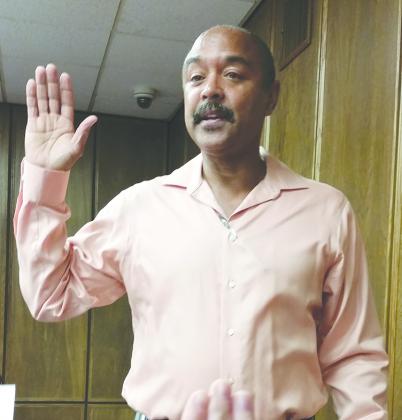Saying it was important to pass an ordinance and that they could go back and revisit the wording later, the Snyder City Council passed the first reading of an ordinance covering new building rules that two advisory groups chose not to recommend.
After a committee appointed by Snyder Mayor Tony Wofford decided it was not the committee’s role to propose a façade ordinance and the Planning and Zoning Commission decided it would not recommend adopting such an ordinance, the Snyder City Council voted 3-2 on Monday to pass an ordinance that would require building owners on several major streets to adhere to new rules for their façades, or store fronts. The ordinance also includes regulations for landscaping and maintenance.
As it is currently worded, the ordinance will require all new buildings, and could require some existing buildings, on Business U.S. Hwy. 180, (25th Street and Coliseum Drive), Business U.S. Hwy. 84, Hwy. 350 (College Ave.) and FM 1605, (37th Street between College Ave. and U.S. Hwy. 180) to meet the new façade and landscaping regulations.
As part of the proposed ordinance, which was changed slightly after a lengthy discussion, all new metal buildings must have at least some of the building’s frontage covered in something other than metal. Retail and commercial buildings built with conventional materials must have at least 25 percent (excluding windows) of the building’s frontage in something other than the primary surface material.
The ordinance originally stated that new metal buildings must have 30 percent of their frontage covered in something other than metal, but council member Steve Rich requested the change in his motion, which was seconded by council member Ben Martin.
All new buildings with gables at the end of structure must have a false front as part of the ordinance that was approved.
Council members and city staff said the façade portion of the ordinance would only apply to new buildings and those that undergo exterior renovations and repairs.
However, the ordinance does not make that clear and only draws the distinction of new metal buildings and new construction with gables. That means existing buildings of conventional construction materials could be subject to the new regulations.
It would be at the city staff’s discretion to determine if an exterior renovation or repair was subject to the new ordinance.
The new ordinance also includes regulations for landscaping and property maintenance.
In commercial zones, all businesses on a half-acre tract or larger will be required to set aside at least 10 percent of their property for landscaping. Businesses located in manufacturing zones will be required to set aside 5 percent of their property. The ordinance does not specify that the regulations only apply to new businesses.
The ordinance will also require all businesses, new and existing, to purchase insurance policies for the maintenance of their landscaping.
As part of the landscaping section, the ordinance outlines what kind of ground cover is permitted for new development projects.
All buildings and property will be subject to the maintenance requirement, which states that a property’s appearance must be “consistent with the degree of care as the neighboring properties.”
Council member Thomas Strayhorn, who voted against the proposed ordinance, said he wasn’t against the idea but questioned some of the wording as vague.
“‘Pleasing aesthetic pattern’ is terribly vague to put in an ordinance,” he said. “It seems open to a lot of questions and would be difficult to enforce.”
Rich said the goal was to “eliminate someone from just sticking up a metal building.”
“We just need to have something in place and then we can work on the wording,” he said.
Planning and Zoning Chairman Bob Martin said the commission discussed the issue during two meetings and told city staff that the members needed more information before reaching a final recommendation for the council.
“The (Wofford-appointed) committee looked at it and they had recommended against it because of the expense and difficulty to enforce. We discussed it at length and our recommendation was that as much as we’d like for it (Snyder) to look nice, we saw it as an undue expense to businesses,” Martin said.
Ben Martin said a business owner he spoke with was in favor of the ordinance because it would protect the investment he made in his property. Martin said that if businesses didn’t want to follow the regulations, they could buy property in another part of town not covered by the ordinance.
Development Corporation of Snyder Executive Director Bill Lavers said national retail chains and restaurants he speaks to expect façade regulations and that it lowers their cost in coming to Snyder because the city doesn’t currently have those types of requirements.
He pointed out that the locally-owned Texas Cajun Café and Pizza Inn both recently spent extra money to improve the appearance of their business exteriors.
Remodeling projects contained completely within a building and new manufacturing or industrial buildings would be exempt from the proposed ordinance.
The council is scheduled to take a final vote on the ordinance during its Aug. 7 meeting.
The council also approved Eddie and Linda Williams’ request that the city abandon and then sell them a 40-foot wide tract located at the undeveloped part of Ave. W between 36th Street and the alley.
At one time the parcel was going to be a roadway. The appraised value is $1,624.
Finance Director Patricia Warren reviewed the city’s 2017-18 budget for the council members who were not present during the previous meeting. No changes to the proposed budget had been made since the previous update.
The council also approved a bid for a mechanical bar screen for the wastewater treatment plant. The bid of $154,020 from J&L Equipment in Amarillo was nearly $60,000 higher than a bid from Aqulitec Corporation in Los Angeles, but the equipment would be all stainless steel as opposed to having plastic parts. The screen was budgeted for $250,000.


